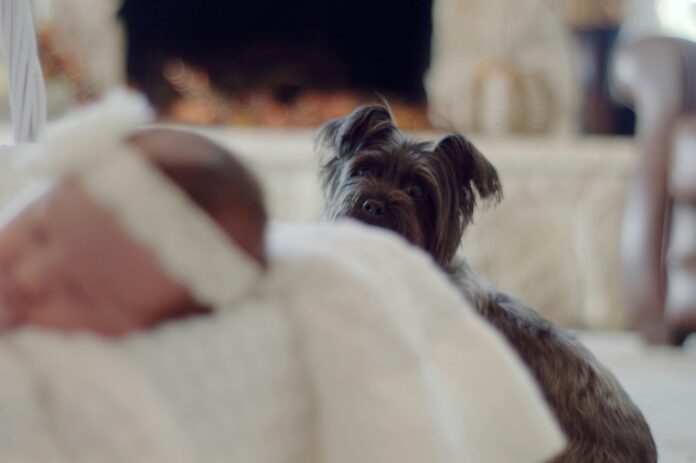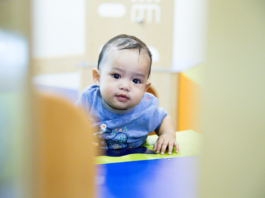Your pets and new baby can live together peacefully. Want to know how? Let’s delve into this guide. Are you expecting a new baby? Exciting times! But let’s remember our fuzzy friends. Living peacefully with your pets and baby takes a bit of planning. Here’s a sweet and helpful guide. It’ll show how to help your pets prepare for their new human sibling. A smooth change for all!
Table of Contents
Setting the Stage for Harmony

Prepare your pets for the new baby before the pitter-patter of little feet fills your home. Start by establishing a routine miming what life will be like when the baby arrives. This includes adjusting feeding schedules, walking routines, and playtime to align with the anticipated changes in your daily rhythm. By gradually introducing these adjustments, your pets can acclimate to the upcoming shifts in their environment, ensuring a smoother transition when the baby arrives.
Creating Safe Spaces for Pets
Just like us, pets love a spot all to themselves. Make unique, calm corners for your pets when getting ready for your new child. It could be a warm spot with a comfy bed or a specific room. Giving your pets a peaceful place helps them feel safe when everything else changes. This soothing spot becomes their haven and keeps things regular as your home changes with your family’s new addition.
Gradual Exposure to Baby Items

Look, your pets might find everything about new babies strange – they smell different, make different noises, and bring along a whole bunch of strange, new things. Weird things like cribs, strollers, and little clothes must be shown to your pets slowly. Guide them to check these things out, but watch them. Make those things a good experience for them. You could try giving treats or verbal praise. Show them some love when they approach the baby’s stuff nicely. Then, when the baby is finally home, your pets are already friendly with these items. This could stop any worried or curious reactions from your pets.
Positive Reinforcement
Your pets love praise, treats, and snuggles. These are perfect rewards when they behave well around baby stuff. Keep doing this so they know it’s good. Do they learn tricks like sitting, staying, or being quiet? Use those when the baby’s around. So, they’ll see the baby as part of good times, not a threat. They’ll know acting excellent means getting treats or love. This helps your pets get along with your new little one.
Scent Introduction

Babies have a distinct scent that can be intriguing and unfamiliar to pets. Help your pets become accustomed to the baby’s scent by bringing home an item that carries the baby’s smell, such as a blanket or piece of clothing, before the baby’s arrival. Allow your pets to sniff and investigate the item under supervision. This gradual introduction helps your pets associate the new scent with a familiar and positive context, reducing potential anxiety or curiosity when the baby comes home. Familiarizing your pets with the baby’s scent in advance eases the transition and promotes a sense of acceptance.
Introducing Your Pets and New Baby
When the day finally arrives to bring your newborn home, orchestrate a gentle introduction between your pets and the new baby. Choose a calm and quiet environment for this initial meeting, allowing your pets to approach at their own pace. Ensure that interactions are supervised, and use a calm and reassuring tone to communicate with your pets. Gradually expose your pets to the baby’s presence, rewarding positive behavior with treats and affection. This gradual introduction establishes a positive relationship between your pets and the family’s newest member.
Maintaining Routine Consistency

Pets thrive on routine, and the arrival of a new baby can bring about significant changes in the household dynamics. While some adjustments are inevitable, strive to maintain consistency in your pets’ routine as much as possible. This includes feeding schedules, playtime, and walks. The surface provides a sense of stability for your pets, helping them navigate the changes with a familiar rhythm. By prioritizing routine consistency, you reassure your pets that, despite the differences, their core needs and rhythms will remain intact.
Monitoring Pet Behavior
Pets communicate through subtle cues; attentive behavior monitoring is essential when introducing a new baby. Observe body language, vocalizations, and changes in behavior that may indicate stress or discomfort. If your pets display signs of anxiety, addressing these concerns promptly is crucial. Consult with a veterinarian or a professional animal behaviorist to ensure your pets receive the support and guidance necessary to adapt to the changes healthily and positively.
Encouraging Positive Interactions

Facilitate positive interactions between your pets and the new baby to strengthen their bond over time. Supervised play sessions, where your pets can engage with the baby in a controlled and positive manner, create opportunities for connection. Use toys, treats, and gentle encouragement to foster positive associations between your pets and the baby. These bonding moments contribute to developing a solid and positive relationship, laying the groundwork for a lifelong companionship between your pets and your growing family.
Incorporating Pets into Baby Activities
As your baby grows, involve your pets in age-appropriate activities that include them as part of the family. Whether it’s gentle petting sessions, interactive play, or supervised outdoor adventures, incorporating your pets into baby activities reinforces their role as valued family members. This inclusion deepens the bond between your pets and your child and fosters a sense of unity within the family unit. Creating shared experiences allows pets and children to grow up together, building a foundation of mutual understanding and companionship.
Professional Guidance

Seeking professional guidance from veterinarians and pet trainers is a valuable resource as you navigate the journey of introducing a new baby to your pets. Veterinarians can provide insights into your pets’ specific needs, offer advice on behavior monitoring, and address any health concerns that may arise during the transition. Trainers specializing in pet behavior can offer tailored strategies for positive reinforcement, addressing specific behaviors and ensuring a smooth integration of your pets into the family dynamic. Professional guidance ensures that your pets and new baby receive the support they need for harmonious coexistence.
Living in Harmony
Getting your pets and new baby ready to meet needs kindness, calmness, and insight. Be ahead of the game, use rewarding techniques, and be steady to help create a happy connection between your pets and your expanding family. Welcoming a new baby isn’t just about more family members. It’s about the bonds and friendship between pets and people making a touching sound that rings in the home. Embrace this change with positivity. With careful planning, your pets and new baby can live together in a kind and peaceful space.




